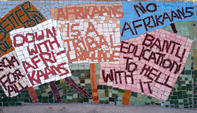Gold Rush
Soweto developed at the same time as Johannesburg, and for the same reason - gold. In 1885, the gold rush was in full swing, prospectors from all over flocked to the newly found gold fields in search of their fortune, either to stake a claim directly or to offer their labour.

Shantytowns rapidly grew next to the gold mines, a mix of nationalities and cultures intertwined living in squalor. As the gold mines became more developed, compounds were built for the labourers. With the success of the gold mines came a greater need for more labour. The compounds were unable to fit everyone in, so shanties were again the only option. Built in squalor, with no or little sanitation, they were pits of misery.
In 1905, during yet another outbreak of bubonic plague in the City of Johannesburg, the City Council took this opportunity to relocate the residents to racially segregated areas. Some were relocated to Alexandria, near present day Sandton, predominantly Indian, Black and Coloured folk, and given freehold title to their land. The majority of the Black population though, were relocated 20 km out of the city to Klipspruit, now known as Pimville in Soweto. These residents were housed on a rental basis. It was supposed to have been a temporary measure, but lasted for 30 years.
Sophiatown Residents
During the 1930’s, more migrant workers kept on arriving to the area, increasing the demand for housing in Johannesburg. The area Orlando was created to house these families, named after the first administrator Edward Orlando Leaky. In the 1940’s, 1000’s of squatters invaded land near Orlando. They were led by James Mpanza, known as the father of Soweto.
Soweto received its name from the first two letters of South Western Township, which is how the township was first called. In 1959, Sophiatown residents were forcibly relocated to Meadowlands, in Soweto, swelling the numbers even more. Sir Ernest Oppenheimer, chairman of Anglo American Corporation, viewed the housing shortage in Soweto as so appalling, that he arranged loans to be made to build better housing for the residents. The Oppenheimer Tower, in Jabulani, Soweto was erected to commemorate this initiative.
Soweto Uprisings

1972 - 1976, was a time of crisis in Soweto and the dawn of the Soweto uprisings. Tension between the West Rand Administration Board and the local residents culminated into a culture of resistance and non-payment of services. Added to this mix, Afrikaans was mandated to be taught to all students in high schools.
This was the final straw, the situation exploded. Students went on a march in defiance of being dictated to and met a wall of bullets that killed many children, amongst them 13 year old Hector Pieterson. In 1983, Soweto achieved its own City Council status. Unfortunately, with very little income forthcoming and inherited backlogs, services could not be delivered.
This gave rise to the rent boycotts of 1986. Nowadays, all the original rental houses have been sold to the tenants, with a government grant to help to pay for them. In the 1980’s private houses developed funded by South African banks, and freehold title is now available to all the properties. Soweto is now a functional part of Joburg, a vibrant mix of opulence and squalor.